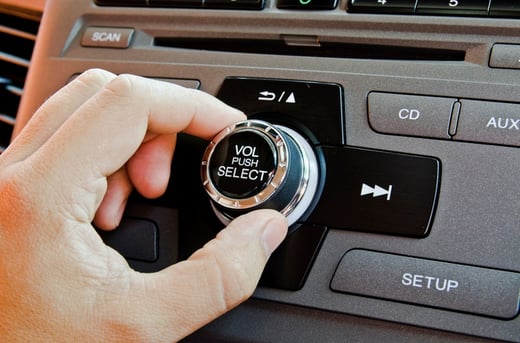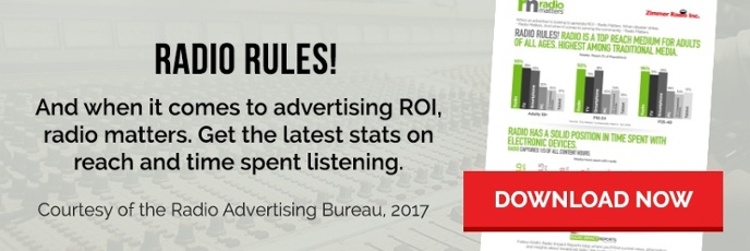 Radio is a rare media channel that reaches nearly all Americans at some point in the day, each and every week. Reaching 91% of Americans over the age of 12, radio provides mass reach, maximizes frequency, and in combination with the right psychographic and demographic data, offers effective targeting. But that alone shouldn’t convince you that radio is a good fit for your marketing strategy.
Radio is a rare media channel that reaches nearly all Americans at some point in the day, each and every week. Reaching 91% of Americans over the age of 12, radio provides mass reach, maximizes frequency, and in combination with the right psychographic and demographic data, offers effective targeting. But that alone shouldn’t convince you that radio is a good fit for your marketing strategy.
We’ve collected facts in three key areas to prove you can use radio to reach your customers and drive sales at your business, no matter which industry you’re in.
In-Car Listening
Even in the digital age, AM/FM radio is still the leader of time spent with audio in-car. This includes both traditional AM/FM radio and AM/FM streams, in spite of options like satellite radio and myriad mobile devices that can stream premium audio through a vehicle’s speakers.
- Of drivers 18 and older that drove or rode in a car in the last month, 82% used AM/FM radio.
- Of those, nearly half (47%) pointed to radio as the primary audio source used while in-car.
- Another 11% used either AM/FM streaming radio or pure-play internet radio most of the time.
- This actually crosses age demos as well. In a study of women last year:
- 79% of women 45-54 pointed to radio as the primary in-car audio source. As did…
- 80% of women 35-44.
- 78% of women 25-34.
- 68% of women and girls 15-24.
- It also crosses demographics. For instance:
- 79% of Hispanics and 77% of African Americans (18 and older) used AM/FM radio in-car in the last month.
- 36% of both demos used AM/FM streaming radio or pure-play internet radio in-car in the last month.
- 46% of Hispanics and 40% of African Americans (18 and older) pointed to AM/FM radio as the primary audio source while in-car.
- 21% of both demos used either AM/FM streaming radio or pure-play internet radio most of the time.
- 88% of adults planning to buy or lease a new vehicle in 2017 stated an AM/FM radio was important to have in-car.
Listening Through Commercial Breaks
You may have the impression that listeners will spin the dial as soon as a commercial comes on, but that simply isn’t the case. Radio is a commercial-friendly medium.
- Radio has an average of more than 93% lead-in audience retention during commercial breaks year-round, but this varies by length of the break:
- 100% of 1 minute breaks.
- 99% of 2 minute breaks.
- 96% of 3 minute breaks.
- 92% of 4 minute breaks.
- 87% of 5 minute breaks.
- 85% of 6+ minute breaks.
- Timing can sometimes be a factor. Commercials during the Morning Drive daypart retain 97% of lead-in audiences on average.
- It can also vary somewhat by format. For instance:
- 90% of lead-in audiences in the 35-64 demo on average are retained by music stations.
- 97% of lead-in audiences in the 18-34 demo on average are retained by spoken word stations.
Impacting Sales
The bottom line for any marketing channel is whether it delivers for your bottom line. After all, every ad is an investment. Radio provides some of the best marketing ROI, across industries.
- Nielsen has linked radio data to 80% of American credit card holders as well as a total of more than 125 million consumers’ transactions. It revealed that for every $1 spent by advertisers on radio, they achieved $6 in incremental sales on average.
- It also revealed three drivers for these returns: buyers spending more per trip when they shop, buyers shopping more often, and generating more buyers.
- Of course, this varied by industry. For example:
- Home Improvement: $9 of incremental sales for every $1 spent.
- 8% increase in total buyers.
- 4% increase in overall sales.
- 2% increase in purchase totals per buyer.
- QSR: $3 of incremental sales for every $1 spent.
- 6% increase in total buyers.
- 6% increase in overall sales.
- 1% increase in purchase totals per buyer.
- Mass Merchandiser: $16 of incremental sales for every $1 spent.
- 2% increase in total buyers.
- 1% increase in overall sales.
- 2% increase in purchase totals per buyer.
This data is far from comprehensive, but it clearly illustrates that radio is an influential force that offers a number of opportunities for marketing your brand. It’s worth taking the time to properly research whether or not radio is a good fit for your business and can help you achieve your unique goals.
A media partner like Zimmer Radio Inc. can help you uncover which dayparts are best for reaching your target audience, as well as which genres will have the most impact. Media partners will also have a complete portfolio of radio stations, each with a distinct brand that can align with your own. For instance, at Zimmer, we have six stations that represent the number one, most listened to media group in Joplin and the surrounding Four States area.

